Topic- 1: WhatsApp Chatbot Integration
GS-3: Science and Technology
The context:
In a significant digital outreach initiative, the Ministry of Youth Affairs and Sports has launched a WhatsApp chatbot integration with the MY Bharat Portal to Enhance Youth Engagement and Experience.
About the WhatsApp Chatbot Integration Initiative:
-
- It is launched by the Ministry of Youth Affairs and Sports.
- It aims to enhance digital engagement and streamline access to services for India’s Youth; the Ministry of Youth Affairs and Sports has launched WhatsApp integration with the MY Bharat portal.
- The WhatsApp chatbot is now live on the MY Bharat Portal and also accessible directly via WhatsApp (7289001515), offering users a more seamless, real-time, and user-friendly way to interact with the platform.
- This release includes core features for all registered MY Bharat users, allowing them to explore Experiential Learning Programs, Volunteering Opportunities, CV creation, Mentorship, Organization Joining/creation, report any issues and access MyBharat Support.
- To start the session in WhatsApp chatbot, individual need to send a message ‘Hi’ to 7289001515 number. Individual login identity shall be identified through OTP and session shall be established.
- In upcoming releases many new features will be introduced like In-app Registrations, Notifications with downloads, Media Uploads for event participation, Reminders and Follow-up, Profile / Task Completion etc.
- The chatbot can be used to send automated reminders, deliver certificates, other resource documents, and share compliance alerts. It will also broadcast campaign content, event highlights, updates on government schemes, best practices, and tool kits to keep youth informed and actively involved.
Key Benefits to Youth:
-
- Convenient access to MY Bharat services through WhatsApp
- Faster onboarding, Event Participation, and Application tracking
- Real-time updates and reminders
- Easy issue reporting and support resolution
- Regular broadcasts on opportunities, schemes, and best practices
- A familiar, mobile-first interface to stay connected with national programs
This integration reinforces the Ministry’s commitment to empowering youth by embedding public services into the digital platforms they use most, making it easier for them to stay connected, engaged, and informed.
MY Bharat is a technology platform designed by Department of Youth Affairs (DoYA) and developed by Digital India Corporation (DIC) MeitY Government of India to put in place an institutional method for engagement of youth force of the country. With the main intent of empowering the youth with Indian Ethos of, ‘Seva Bhav’ and ‘Kartavya Bodh’ this platform provides options for participation in various volunteering and learning activities, getting mentorship from experts, creation of youth profile & CV, connect with other youths and other exiting capacity building activities.
Source: PIB
Topic- 2: Adi Karmyogi Beta Version – A Responsive Governance Initiative
GS-2: Governance
The context:
The Ministry of Tribal Affairs marked a significant milestone with the launch of the Adi Karmyogi Beta Version during the two-day “Adi Anveshan” National Conference. Union Tribal Affairs Minister Shri Jual Oram emphasized a shift from tokenism to transformational, empathetic, and community-driven governance in tribal areas.
The Key Highlights:
-
- The Adi Karmyogi programme aims to build a motivated team of officers and changemakers who work directly at the grassroots level.
- It targets reaching 1 lakh tribal villages and habitations, and plans to train around 20 lakh stakeholders through a network of trainers at state, district, and block levels.
- Secretary of the Ministry highlighted the need to change the attitude of government officials and promote a sense of purpose and responsibility.
- The importance of collaboration across departments, grassroots involvement, and nurturing mentors within the system.
- The conference featured discussions on promoting tribal entrepreneurship by developing a supportive startup ecosystem in tribal areas.
- A special focus was given to expanding the Dharti Aaba Janjatiya Gram Utkarsh Abhiyan (DAJGUA) to better integrate services and improve last-mile delivery.
- Officials discussed strengthening Tribal Research Institutes (TRIs) to serve as both research bodies and implementation partners.
- There was also a review of flagship schemes like PM JANMAN and DAJGUA, alongside discussions on tackling health challenges such as Sickle Cell Disease and effectively implementing the Forest Rights Act.
A powerful segment of the event featured the screening of short films on the Dharti Aaba Janbhagidari Campaign – hailed as India’s largest tribal empowerment campaign. The films showcased impressive achievements during the last 11 days, including:
-
- 31,000+ IEC & service delivery camps held
- 74 lakh+ tribal citizens reached
- 3.12 lakh Aadhaar registrations
- 3.22 lakh Ayushman cards issued
- 90,500 PM-Kisan enrollments
- 1.14 lakh new Jan Dhan accounts opened
- 48,000 PM Ujjwala gas connections provided
These outcomes span across 31 States/UTs, 501 districts, and over 2,390 blocks, demonstrating the scale and impact of the campaign.
Way Forward: Building an Institutional Culture of Responsive Governance
-
- As part of forward planning, participants shared suggestions for formulating new schemes or modifying existing ones, with an emphasis on rationalization and community-centric design. States stressed that changes must reflect the lived realities and aspirations of tribal communities to ensure meaningful outcomes.
- The Ministry of Tribal Affairs successfully organized a two-day National Conference titled “Adi Anveshan”on 26th and 27th June 2025, at Vanijya Bhawan, New Delhi.
About the Pradhan Mantri Janjati Adivasi Nyaya Maha Abhiyan (PM-JANMAN):
-
- PM-JANMAN was launched on 15th November 2023, on Janjatiya Gaurav Diwas, to improve the socio-economic welfare of PVTGs.
- It is implemented by the Ministry of Tribal Affairs, in collaboration with the State governments and the PVTGs communities.
- It encompasses various sectors, including safe housing under the PM-Awas Scheme, access to clean drinking water, improved healthcare, education, nutrition, road and telecommunications connectivity, as well as opportunities for sustainable livelihoods.
- The plan also includes the establishment of Van Dhan Vikas Kendras for trading in forest produce, off-grid solar power systems for 1 lakh households, and solar street lights.
- The scheme is expected to enhance the quality of life and well-being of the PVTGs, by addressing their multiple and intersecting forms of discrimination and exclusion, and by recognizing and valuing their unique and valuable contribution to national and global development.
About the Dharti Aaba Janjatiya Gram Utkarsh Abhiyan:
-
- Originally named the PM Janjatiya Unnat Gram Abhiyan (PM-JUGA), is an umbrella scheme to implement existing schemes across 63,000 Scheduled Tribe-majority villages.
- Dharti Aaba refers to Birsa Munda, a 19th-century tribal leader and anti-colonial icon from Jharkhand.
- The initiative aims toaddress critical gaps in social infrastructure, health, education, and livelihood through 25 interventions implemented by various 17 Ministries and Departments of the Government of India.
- Originally named the PM Janjatiya Unnat Gram Abhiyan (PM-JUGA), is an umbrella scheme to implement existing schemes across 63,000 Scheduled Tribe-majority villages.
Source: PIB
Topic- 3: Statistical Report on Value of Output from Agriculture and Allied Sectors (2011-12 to 2023-24)
GS-3: Economy
The context:
National Statistics Office (NSO), Ministry of Statistics and Programme Implementation (MoSPI) released the annual publication of “Statistical Report on Value of Output from Agriculture and Allied Sectors (2011-12 to 2023-24)” on 27th June 2025.
The Key Highlights:
-
- Gross Value Added (GVA) of agriculture and allied sectors at current prices registered a growth of about 225%, increasing from ₹1,502 thousand crore in 2011-12 to ₹4,878 thousand crore in 2023-24.
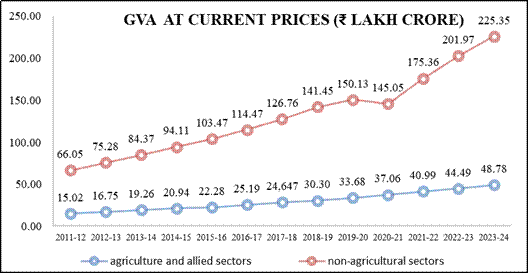
-
- Gross Value of Output (GVO) from the agriculture and allied sector at constant prices has shown steady growth from ₹1,908 thousand crore in 2011–12 to ₹2,949 thousand crore in 2023–24, marking an overall increase of approximately 54.6%.
Share (%) of crop, livestock, forestry and fishing in total GVO of Agriculture and allied sectors at constant prices

-
- Crop sector with GVO at 1,595 thousand crore remains the largest contributor to total GVO (at constant prices) of agriculture and allied sectors with share of 54.1% in 2023-24. Cereals and fruits & vegetables together accounted for 52.5% of total crop GVO in 2023-24.
- Percentage share of different crop groups in GVO of Crop sector in 2011-12 and 2023-24 (at constant prices)

-
- Among the cereals, only paddy and wheat constitute approximately 85% of GVO (at constant prices) of all cereals in 2023-24.
- Share of GVO of top 3 cereals at constant prices in 2011-12 and 2023-24
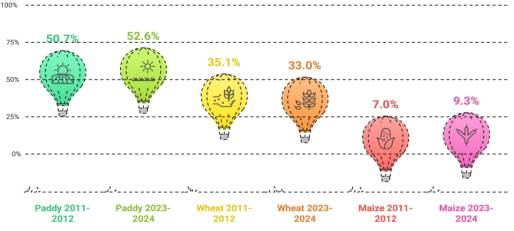
-
- Five States namely Uttar Pradesh, Madhya Pradesh, Punjab, Telangana and Haryana contributed nearly 53% of GVO (at constant prices) of cereals in 2023-24. With reduced share (18.6% in 2011-12 to 17.2% in 2023-24) Uttar Pradesh maintained the top most position.
- Share of top five States in GVO of cereals at constant prices in 2011-12 and 2023-24
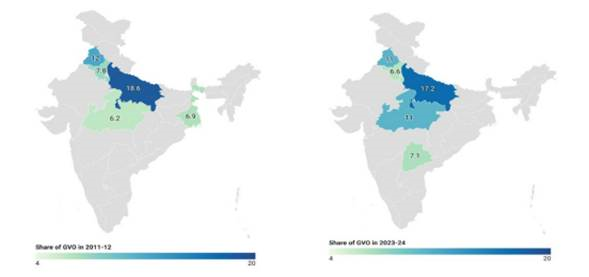
-
- In the fruit group in 2023-24, constant prices GVO of Banana (47.0 thousand crore) has surpassed that of Mango (46.1 thousand crore). Mango was the top-most contributor in GVO (at constant prices) in fruit group consistently from 2011-12 to 2021-22.
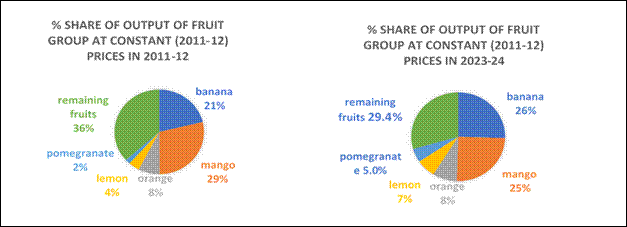
-
- Potato remains the top-most contributor in GVO (at constant prices) of vegetable group during 2011-12 to 2023-24. GVO of potato has increased to 37.2 thousand crore in 2023-24 from 21.3 thousand crore in 2011-12.
- Floriculture experienced significant growth in GVO at constant prices, nearly doubling from ₹17.4 thousand crore in 2011–12 to ₹28.1 thousand crore in 2023–24, reflecting rising commercial interest and diversification in horticulture.
- The composition of State-wise contributions to the GVO (at constant prices) for ‘fruits and vegetables’ and floriculture has changed noticeably from 2011–12 to 2023–24, indicating shifts in production dynamics and regional agricultural growth.
- Share of top five States in GVO of fruits and vegetables and floriculture at constant prices in 2011-12 and 2023-24
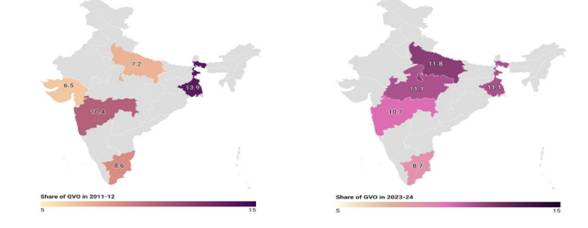
-
- Share of Madhya Pradesh (19.2%) in GVO of ‘condiments & spices’ in 2023-24 made a dramatic leap becoming the top contributor in this group, while Karnataka and Gujarat followed with 16.6% and 15.5%, respectively.
Share of top five States in GVO of condiments & spices at constant prices in 2011-12 and 2023-24
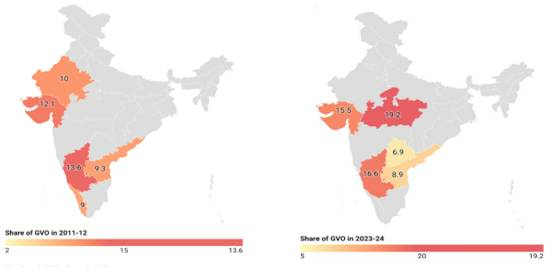
-
- GVO of livestock products has increased from ₹488 thousand crore in 2011-12 to ₹919 thousand crore in 2023-24, making it one of the fastest-growing components of agriculture & allied activities. Milk remained dominant in this sector in 2023-24, however share has decreased from 67.2% to 65.9% during 2011-12 to 2023-24. Share of meat group in total GVO of livestock sector increased from 19.7% to 24.1% during 2011-12 to 2023-24 (at constant prices).
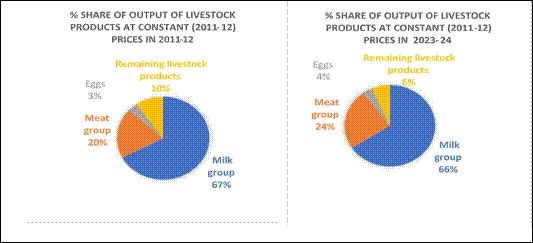
-
- ‘Forestry and Logging’ sector has displayed moderate but consistent growth from ₹149 thousand crore to ₹227 thousand crore during 2011-12 to 2023-24. Share of value of industrial wood surged from 49.9% in 2011-12 to 70.2% in 2023-24.
- ‘Fishing and aquaculture’ sub-sector is becoming increasingly important in India’s agricultural GVO with its contribution significantly rising from 4.2% in 2011-12 to 7.0% in 2023-24. Share of inland fish has decreased from 57.7% to 50.2% during 2011-12 to 2023-24 whereas, share of marine fish has increased from 42.3% to 49.8% during 2011-12 to 2023-24.
- Significant shifts in GVO (at constant prices) in Fisheries has been observed in the two major contributing States of West Bengal and Andhra Pradesh during the period 2011-12 to 2022-23.
- Share of top five States in GVO fishing and aquaculture at constant prices in 2011-12 and 2023-24

Source: PIB
Topic- 4: Sugamya Bharat App
GS-2: Governance
The context:
The Government has revamped the Sugamya Bharat App, making it more intuitive and user-friendly to enhance accessibility for persons with disabilities (Divyangjan) and elderly citizens. The upgraded app now features an AI-powered chatbot that provides real-time information on government schemes and initiatives.
About the Sugamya Bharat App (SBA):
-
- It is a flagship initiative of the Government of India dedicated to enhancing accessibility for divyangjan and elderly citizens in India, has been recently revamped to provide a more user-friendly and impactful experience.
- The app has 14,358 total registered users and witnessed 83,791 app downloads (82,291 on android platforms and 1500 on iOS platforms) across both android and iOS platforms. The Sugamya Bharat App is currently available for downloadon Google Play Store for Android devices and on Apple App Store for iOS platforms.
- It was launched in 2021 by the Department of Empowerment of Persons with Disabilities (DEPwD), Union Ministry of Social Justice and Empowerment, the app serves as an essential platform for citizens to report accessibility issues across public infrastructure, transportation, and information and communication technology (ICT) systems.
- Users can easily upload geo-tagged photos of locations where accessibility barriers exist, enabling authorities to take prompt corrective action. Since its inception, the app has received a total of 2,705 complaints, of which 1,897 have been successfully resolved, reflecting the government’s commitment to creating an inclusive environment for all.
- The DEPwD continues to encourage public to actively participate in reporting accessibility challenges and supporting the Government’s vision of a barrier-free India.
The recent revamp of the App introduces several enhanced features, including:
-
- A more intuitive and user-friendly interface
- AI-powered chatbot support to assist users in real time
- Circulars and notifications about new initiatives related to accessibility
- Integration of government schemes and other valuable resources for persons with disabilities
Source: PIB
Topic- 5: Teak Leaf Extract Emerges as Natural Biodegradable Shield Against Harmful Laser Radiation
GS-3: Environment and Ecology
The context:
Scientists at the Raman Research Institute (RRI), under the Department of Science and Technology (DST), have identified a novel use of teak (Tectona grandis) leaf extract as a natural, biodegradable laser shield. Rich in anthocyanins—reddish-brown pigments—teak leaves can offer protection to sensitive optical sensors and human eyes from high-power laser radiation used in medical, military, and industrial applications.
The Key to Scientific Discovery:
-
- The leaves, often thrown away as waste, contain pigments like anthocyanins that show special light-absorbing properties.
- These pigments have nonlinear optical (NLO) properties, meaning they behave differently under intense light, making them useful for laser protection.
- Teak leaf extract can protect human eyes and sensitive optical sensors from harmful laser rays used in medical, military, and industrial devices.
- Researchers extracted dye from the leaves by drying, powdering, soaking, and purifying them using ultrasonication and centrifugation.
- When green laser light was passed through the dye, it absorbed more light as the intensity increased, a phenomenon called reverse saturable absorption (RSA).
- RSA is important because it helps materials block dangerous high-power lasers more effectively as intensity rises.
- The study shows that teak leaf dye can be a natural, safe, eco-friendly, and low-cost alternative to synthetic materials like graphene and metal nanoparticles.
- This could lead to greener technologies for making laser protection gear such as goggles, sensor shields, and coatings.
- Scientists plan to work on improving the dye’s stability so it can be used in long-term commercial photonic devices.

Source: PIB
Spread the Word
